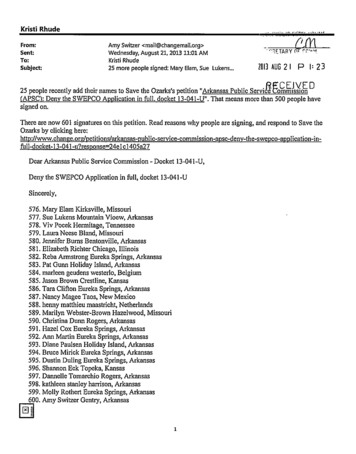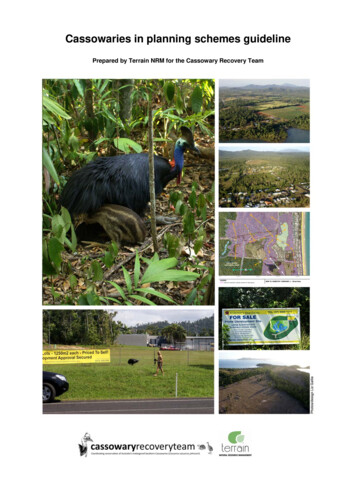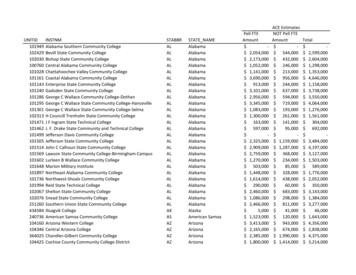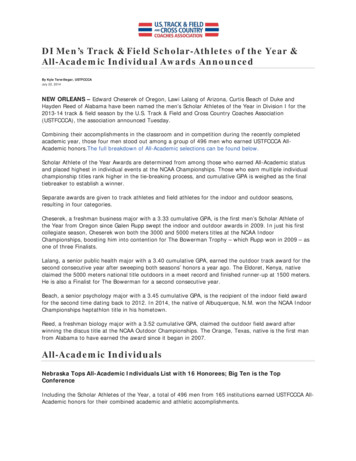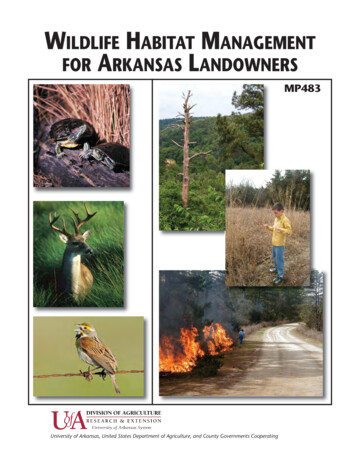
Transcription
WILDLIFE HABITAT MANAGEMENTFOR ARKANSAS LANDOWNERSMP483University of Arkansas, United States Department of Agriculture, and County Governments Cooperating
TABLEOFIntroduction . . . . . . . . . . . . . . . . . . . . . . . . . . . . . . . . 1Preparing a Wildlife Management Plan . . . . . . . . 1Habitat Practices . . . . . . . . . . . . . . . . . . . . . . . . . . . .Cropland Management . . . . . . . . . . . . . . . . . . . .Conservation Tillage . . . . . . . . . . . . . . . . . . .Crop Rotation . . . . . . . . . . . . . . . . . . . . . . . . .Contour Strip Cropping . . . . . . . . . . . . . . . .Field Borders and Turn-Rows . . . . . . . . . . . .Fallow Fields . . . . . . . . . . . . . . . . . . . . . . . . . .Buffer Strips/Grassed Waterways . . . . . . . .Field Shelterbelts, Windbreaks andFencerows . . . . . . . . . . . . . . . . . . . . . . . . . .Wildlife-Friendly Tips for CroplandManagement . . . . . . . . . . . . . . . . . . . . . . .Cropland Review . . . . . . . . . . . . . . . . . . . . . .23334444556Grassland Management . . . . . . . . . . . . . . . . . . . 6Grazing . . . . . . . . . . . . . . . . . . . . . . . . . . . . . . . 7Hay-Cutting . . . . . . . . . . . . . . . . . . . . . . . . . . 8Fertilizing and Liming . . . . . . . . . . . . . . . . . . 8Overseeding With Legumes . . . . . . . . . . . . . 8Prescribed Burning . . . . . . . . . . . . . . . . . . . . . 8Converting to Native Grassesand Forbs . . . . . . . . . . . . . . . . . . . . . . . . . . 9Brushy Fencerows and Thickets . . . . . . . . . . 9Wildlife-Friendly Tips forGrassland Management . . . . . . . . . . . . . . 9Grassland Review . . . . . . . . . . . . . . . . . . . . . . 10Forest and Woodland Management . . . . . . . . . 10Hardwood Forest Stands . . . . . . . . . . . . . . . . 11Pine Forest Stands . . . . . . . . . . . . . . . . . . . . . 12Prescribed Burning . . . . . . . . . . . . . . . . . . . . . 12Soil Erosion . . . . . . . . . . . . . . . . . . . . . . . . . . . 13Wildlife Openings . . . . . . . . . . . . . . . . . . . . . . 13Snags and Downed Wood . . . . . . . . . . . . . . . 14Fence Out Livestock . . . . . . . . . . . . . . . . . . . . 14Streamside Management Zones . . . . . . . . . . 14Wildlife-Friendly Tips for Forestsand Woodlands . . . . . . . . . . . . . . . . . . . . . 16Forests and Woodlands Review . . . . . . . . . . 17CONTENTSWetlands Management . . . . . . . . . . . . . . . . . . . . 17Grassy, Weedy Areas . . . . . . . . . . . . . . . . . . . 18Flooded Cropland . . . . . . . . . . . . . . . . . . . . . 19Bottomland Hardwood Management . . . . . 19Ponds and Small Lakes . . . . . . . . . . . . . . . . . 20Natural Sloughs . . . . . . . . . . . . . . . . . . . . . . . 20Wildlife-Friendly Tips for Wetlands . . . . . . 20Wetlands Review . . . . . . . . . . . . . . . . . . . . . . 21Idle Area Management . . . . . . . . . . . . . . . . . . . . 21Old Fields . . . . . . . . . . . . . . . . . . . . . . . . . . . . . 21Fencerows . . . . . . . . . . . . . . . . . . . . . . . . . . . . 22Brushpiles . . . . . . . . . . . . . . . . . . . . . . . . . . . . 22Abandoned House Sites . . . . . . . . . . . . . . . . 22Pond Banks . . . . . . . . . . . . . . . . . . . . . . . . . . . 23Streambanks and Drainage Ditches . . . . . . . 23Brushy Draws . . . . . . . . . . . . . . . . . . . . . . . . . 24Springs and Seeps . . . . . . . . . . . . . . . . . . . . . . 25Shallow Water Areas . . . . . . . . . . . . . . . . . . . 25Glades, Cliffs and Rocky Outcrops . . . . . . . 25Wildlife-Friendly Tips for Idle Areas . . . . . . 26Idle Areas Review . . . . . . . . . . . . . . . . . . . . . . 26Wildlife Food Plots . . . . . . . . . . . . . . . . . . . . . . . 27Wildlife-Friendly Tips for Food Plots . . . . . 27Wildlife Food Plots Review . . . . . . . . . . . . . . 28Resources . . . . . . . . . . . . . . . . . . . . . . . . . . . . . . . . . . 28Private Lands Professionals . . . . . . . . . . . . . . . . 29Books and Guides . . . . . . . . . . . . . . . . . . . . . . . . 29Plant Identification . . . . . . . . . . . . . . . . . . . . . 29Wildlife Identification . . . . . . . . . . . . . . . . . . 30Habitat Management . . . . . . . . . . . . . . . . . . . 30Fact Sheets . . . . . . . . . . . . . . . . . . . . . . . . . . . . . . 31Wildlife Habitat Practices . . . . . . . . . . . . . . . 31Soil Testing . . . . . . . . . . . . . . . . . . . . . . . . . . . . 31Wildlife Enterprises/Hunting . . . . . . . . . . . 31Wildlife Species . . . . . . . . . . . . . . . . . . . . . . . . 31Forestry . . . . . . . . . . . . . . . . . . . . . . . . . . . . . . 31Timber Management . . . . . . . . . . . . . . . . . . . 32References . . . . . . . . . . . . . . . . . . . . . . . . . . . . . . . . . 32Acknowledgments . . . . . . . . . . . . . . . . . . . . . . . . . . 32Cover Photo Credits:Turtle photo by Lynn Betts, USDA Natural Resources Conservation Service; deer photo by John Stehn,U.S. Fish and Wildlife Service; bird photo by Charles Mills; fire photo by Frances Rothwein, U.S. ForestService; and snag and child photos by Becky McPeake, University of Arkansas Division of Agriculture.
WILDLIFE HABITAT MANAGEMENT FOR ARKANSAS LANDOWNERSBy Becky McPeake, Professor – Wildlife, and Rex Roberg, Program Associate – Wildlife ManagementUniversity of Arkansas Division of Agriculture, Little Rock, Arkansas IntroductionWhether you own five or five thousand acres,implementing a few habitat improvements onyour property can help wildlife. This handbookintroduces ideas for improving your land forwildlife and provides sources for additionalinformation. Some habitat practices are fairlysimple while others require contacting a privatelands biologist, forester, Extension agent, districtconservationist or other professional for assis tance (Figure 1). Contact information forassistance and additional resources are listed atthe end of this handbook.Figure 1. Your local county Extension agent can suggestsoil amendments based on a soil test, herbiciderecommendations to control invasive plants and othermethods to improve wildlife habitat on your property.Photo by Kevin Quinn, University of Arkansas Division ofAgriculture.For many landowners, the most difficult partof improving wildlife habitat on your property isgetting started. The key is to begin with a fewhabitat improvements and add a few more eachyear. Improving habitat is just one component ofa wildlife management plan. A wildlife manage ment plan also includes population managementand harvest strategies if managing game species.Having a plan will help make the best use ofyour land for wildlife while avoiding mistakes.Wildlife management is both an art andscience. The “science” in this booklet is based onyears of research about species and habitats. The“art” is figuring out what works best on yourparticular piece of land, which may take months,years or even a lifetime to determine. Preparing a WildlifeManagement PlanA wildlife management plan will improveyour chances of increasing wildlife on yourproperty. A management plan outlines a courseof action so that good habitat is created andnot inadvertently destroyed. A plan will alsoidentify a sequence for implementing habitatpractices to maximize efficiency and produce thebest outcomes for wildlife. Management plansare not static – they are working documents thatcan change depending on plant responses toyour practices, wildlife usage, economic costs,seed availability, weather conditions andother factors.A management plan will help match habitatto the needs of wildlife species you want toencourage. Often it is useful to target your plantoward specific species or feature species. Thosehabitat practices which benefit a feature specieswill also benefit a variety of other wildliferequiring similar habitat. Conversely, somehabitat practices may reduce or harm habitat forother wildlife. It is important to recognize whatyou are “giving up.” A simple example iscreating small openings of 5 acres in a matureoak forest. Openings may benefit turkey andfoxes but reduce habitat for woodpeckers andgray squirrels. These tradeoffs need to beconsidered carefully before implementing anymanagement plan.A map (Figure 2) aides in identifying wherehabitat improvements are needed on your prop erty. The size and arrangement of newly createdhabitat affects species responses. Cottontails dowell in habitat consisting of clovers and nativeforbs, native warm-season grasses, blackberrythickets and brushpiles in areas of one to fiveacres. Bobwhites also use this habitat, but addi tionally they need shrubby areas, woodlands andold fields located within 40 to 80 acres. As such,the landowner needs to visualize the location ofcurrent and future habitat on a map. Somehabitats require periodic maintenance such asburning or mowing every one to three years 1
habitat practices will be implemented. Aerialphotographs of your property are available atno charge from the Natural Resources Con servation Service (http://offices.sc.egov.usda.gov/locator/app). Aerial photos are also avail able on the internet through the SpatialAnalysis Laboratory at the University ofArkansas at Monticello (http://sal.uamont.edu/)or Geostor (http://www.geostor.arkansas.gov) orprivate companies such as TerraServer(http://terraserver-usa.com/) and Google Earth(http://earth.google.com/). A way to assess your success and knowwhen your objectives have been achieved.For example, “Records will be kept of thenumber of bluebirds nesting in nest boxes,the number of eggs laid and the number offledglings.” A budget. Determine how much you arewilling to spend. Include costs for suppliessuch as tree saplings or lumber for buildingbird houses, equipment, fuel, labor orprofessional services.Figure 2. Mapping your habitat will help identify areasneeding improvement.to keep grasslands in an early successional stage.The sequence of when these disturbances occurshould be written in the plan and labeled onthe map.In summary, a good management plancontains the following: A clear set of objectives identifying thefeature species with measurements ofsuccess. For example, a good objectivewould be: “Increase the number of nestingeastern bluebirds on the property.” A description of the area including itslocation, number of acres, soil type(s), landuse, vegetative cover and current wildlifepopulations. A description of habitat requirements for thefeature species. For example, eastern blue birds are cavity nesters, so they require snagsor artificial nesting structures. Bluebirdsthrive on the edge of open areas includingold fields, pastures, yards and utility right-of ways. These open areas should harbor plentyof insects (their food source) with limitedpesticide use and be located near scatteredareas of hardwoods. A plan of action for implementing the habitatpractices. Use a sketch map or mark on anaerial photograph to illustrate where your2 Think strategically about habitat needs forspecies with home ranges larger than your prop erty size, such as white-tailed deer or migratorysongbirds. Use aerial maps to determine whathabitat is lacking in your area. Develop a plan toprovide the limiting habitat and attract wildlifeonto your property. Habitat PracticesWhether you own cropland, grassland,woodland, idle areas, wetlands or a combinationof these, implementing the practices outlined inthis handbook can dramatically improve wildlifehabitat and ultimately the number of wildlifespecies on your land. Selecting the correct habitatpractices for your property is a big decision.The suitability of a particular habitat practicedepends on your current land use and soilcapabilities. It also depends on how much timeand financial resources you are willing to invest.Again, start with a few practices and plan toexpand or add a few practices each year. Learnwhat works and doesn’t work on your propertyby keeping good records.
Cropland ManagementMinor changes in an area’s crops can have amajor effect on wildlife numbers. This sectiondiscusses management practices for crop fieldsand adjacent areas that are practical, profitableand beneficial to wildlife.Conservation TillageMany land managers consider conservationtillage to be the most promising single practicefor reducing soil erosion. It is also very beneficialfor wildlife, especially bobwhites and uplandsongbirds. Conservation tillage is a broad termthat refers to several tillage methods that main tain crop residue – stubble, grain and other plantseeds – on the field surface. These tillagemethods control erosion, conserve soil moistureand increase organic matter, resulting in betterfield soil conditions. Studies have shown thatconservation tillage fields can have yields thatequal or exceed conventional tillage fields.In addition, production costs are less forconservation tillage systems.Residues from conservation tillage provideboth food and cover for wildlife (Figure 3). Inparticular, waste grain and weed seeds left afterharvesting are staple foods for wildlife in winter.Rather than burning rice stubble, roll the stubbleand catch rainfall to control red rice and otherweed seeds. This practice causes red rice togerminate and then be killed by frost before theseed is mature. Catching rainwater and/orflooding fields can encourage use by ducks,which eat large quantities of red rice seed.Studies show heavy duck feeding during winterreduces the number of red and white rice grainson and in the soil by 97 percent. Rice fields canbe managed to attract waterbirds to red riceinfested fields immediately after rice harvest inthe late summer or fall until late February.Currently, conservation tillage methodsdictate an increase in pesticide use. Properapplication of these pesticides will reduce bothproduction costs and hazards to the environ ment. However, many wildlife species rely oninsects as a food source. For example, insects arean important food source during the criticalearly-life stages for bobwhite chicks and turkeypoults in the spring. Set aside bugging areas(areas where no pesticides are applied) for thesespecies in locations which won’t impact cropproduction.Crop RotationCrop rotation is simply planting differentcrops in the same field from year to year. Longterm rotation means planting three or four differ ent crops before returning to the original crop.These practices increase the health of the crop ping system and add plant diversity to the land.Continuous cropping means that the crops ina field do not change each year. Crop diseaseexperts report that the highest risk for cropdiseases results from continuous cropping. Insectproblems are also more prevalent under thissystem, so more pesticides are needed. Most cornand soybean diseases and associated pests can becontrolled by a simple crop rotation.Figure 3. Residue from this corn crop will reduce soilerosion and benefit wildlife. Photo by Jeff Vanuga, USDANatural Resources Conservation Service.Legumes are always a good choice – andoften a necessity – for rotation because they addnitrogen to the soil and reduce fertilizer require ments for next season’s crop. Legumes also makeideal wildlife nesting cover and food if mowingis delayed until after July 15. Clovers and vetchcan be seeded into row crops after the last 3
cultivation to reduce erosion, add nitrogen andprovide wildlife cover during the winter. Orconsider planting a week or few days before cropharvest so that clover and vetch can germinateand grow without the risk of being shaded outby the crop.Small grain crops, such as wheat and oats,provide food and nesting cover for a variety ofwildlife species. The stubble of these crops, cuthigh and left undisturbed, makes excellentbrood-rearing habitat for bobwhites. The seeds ofannual plants associated with small grain stubbleprovide food for wildlife.Turn-rows planted to a grass/legumemixture will help control soil erosion, providespace to turn equipment and serve as a roadwayalong the edge of the field. Native grass/legumeborders also provide cover for ground-nestingbirds such as meadowlarks and bobwhites.These areas should be mowed at two-year inter vals to prevent woody sprout invasion. Mowingshould be done in mid-July or later after the peakof the nesting season. If noxious weeds are not aproblem, you may consider allowing turn-rowsto grow native vegetation. These can be mowedor disked on a two- or three-year rotation tocontrol woody plants and provide a diverse foodsource for wildlife.Contour Strip CroppingFallow FieldsContour strip cropping is when row crops areplanted in strips along the natural contour of theslope and next to a grass strip. Contour stripcropping provides erosion control and plantdiversity. These strips of grass, legumes or smallgrains act as filters that trap sediment and slowwater runoff. The strip width is dictated by theseverity of the erosion problem and the slope ofthe field. Where erosion is severe, permanentgrass strips can be maintained. A nativegrass/legume mixture can be planted that isbeneficial to wildlife. In some years, the seed andhay harvested from these strips can producemore income per acre than the adjacent rowcrops. Avoid using fescue, bermudagrass orbahiagrass as these have minimal wildlife value.Strips seeded to grass/legume mixturesserve as travel lanes and cover for wildlife andhunting lanes for rodent-consuming barn owls.These strips also provide nesting and roostingcover and, if possible, should not be moweduntil mid-July or later.Fallow fields are crop fields which lie idleduring part or all of the growing season.Every year thousands of acres of idled croplandin Arkansas are available for wildlife habitat.These fallow fields can provide wildlife with theold-field weeds and grasses they need for foodand cover.Buffer Strips/Grassed WaterwaysBuffer strips or grassed waterways may beused as outlets for water collected from crop lands or terrace systems built on farmlands tocontrol erosion. These waterways vary in sizeaccording to the size of the drainage area and areseeded to perennial grasses, legumes or both.Field Borders and Turn-RowsA grassed waterway is helpful in all applica tions where active cropping is disturbing the soilregularly. In many cases a wooded draw mayfunction as an excellent water outlet for terracesor cropland if it is not actively eroding. In addi tion, wooded draws can provide critical cover forwildlife.Field borders can be seeded to grass/legumemixtures that are attractive to wildlife. Whenplanted around crop fields, native warm-seasongrasses such as big bluestem and switchgrassserve as valuable nesting, brood-rearing and con cealment cover for wildlife. These warm-seasongrasses may be hayed after mid-July whenadjacent crops provide cover.Most native warm-season grasses can beplanted on grassed waterways to help controlerosion, provide wildlife cover and producehigh-quality hay. Mow after the peak ofbobwhite and upland songbird nesting andbrooding season which ends about mid-July orlater. This delay in mowing will ensure groundnesting birds and mammals are spared.4
Field Shelterbelts, Windbreaks andFencerows Use winter cover crops for green browse,erosion control and wildlife cover.Trees planted as windbreaks can reduce windvelocities on their downwind side for distancesup to 10 to 20 times the height of the trees,depending upon the species and density. Hard wood or deciduous trees, which shed their leavesin the fall, are not as effective as evergreens forwinter protection. Their bare limbs will reducewind velocities and offer some amount of protec tion, however. Field windbreaks reduce soilerosion, conserve soil moisture and provide foodand cover for wildlife. Plant native grass/legume border stripsaround all or a portion of crop fields.Woody fencerows next to crop fields orpastures (Figure 4) provide many of the samebenefits as windbreaks. Natural woodyfencerows can be encouraged by not spraying ormowing next to the fence. When protected fromclipping, fencerows can develop into naturaltravel lanes for wildlife. Plant clumps of treesand shrubs or spread seeds of vines and shrubsalong fencerows to encourage plant growth. Disk strips at two- to three-year intervals (orup to five years if growth is slow) to controlwoody vegetation. (Figure 5)DiskYear11DiskYear22DiskYear33Figure 5. Rotational strip disking provides wildlife adiversity of plants for food and cover. Allow shallow draws to re-vegetate naturally,or plant warm-season grasses or a grass/legume mixture. Delay mowing until afterJuly 15 to avoid nesting losses and reducenewborn fawn mortality.Figure 4. A brushy fencerow provides travel and escapecover for cottontails, songbirds and bobwhites.Photo by Tom Jacobs.Wildlife-Friendly Tips forCropland Management Implement conservation tillage systemswhenever feasible and practical. Leave unplowed borders or strips duringspring plowing, or plant a cover to wheat oroats on the plowed land in the fall. Minimize chemical applications. Rotate crops to include forage and smallgrains. Seed waterways to native grass/legumemixtures that are beneficial to wildlife. Delaymowing until after the peak of the nestingand brooding season (July 15 or later) toprotect nesting wildlife and reduce fawnmortality. Establish filter strips of native grasses andshrubs around ponds in crop fields to reducesedimentation and add wildlife cover. Establish or protect woody draws andfencerows. Leave at least one-quarter acre of grain cropsunharvested for each 40 acres of crop field.Leave crops in patches or strips near cover. 5
Plant no-till beans in wheat stubble, anddon’t burn the stubble. Roll rice stubble and catch rainfall or floodstarting immediately after rice harvest andhold water until the end of Februaryeach year.Cropland ReviewThe following questions will helpevaluate your current management and itsbenefits for wildlife. Ideally, you shouldanswer “yes” to every question.1Do you currently use conservationtillage methods such as crop rotation,no-till and contour cropping?Conservation tillage residues provide bothfood and cover for wildlife.2Do you perform land improvements forwildlife on fallow fields? These areas caneasily be enhanced for wildlife habitat.3During harvest, do you leave a row ortwo of grain at the field edge? This stand ing grain provides food and cover for wildlifeduring winter months.4Do you avoid heavy pesticide or herbi cide applications? When applied in excessof label directions, pesticides and herbicidesmay eliminate important wildlife foodsources by destroying weed seeds and insectsin noncrop areas.5Are your farm’s field draws and water ways vegetated with native plants toprevent erosion and sedimentation?These areas can be planted in vegetationfavorable to bird and nongame wildlifenesting and foraging.Grassland ManagementGrasslands provide many kinds of wildlifewith food and cover. The grasshopper sparrowand meadowlark are open grassland nesters.Cottontails, bobwhites and turkeys also nest ingrasslands but prefer areas near woods or brush(Figure 6). Grasslands also control soil erosion.6 Figure 6. Warm-season grasses provide cover for manywildlife species including songbirds and deer.Photo by John J. Mosesso, courtesy of life.nbii.gov.Few native grasslands exist in Arkansasexcept for a small number of unplowed prairieremnants scattered over the state. Assistance formaintaining or establishing prairies is availablefrom the Arkansas Natural Heritage Commis sion, Arkansas Game and Fish Commission andThe Nature Conservancy.A pasture is a type of grassland which is usedto graze livestock. Pastures can be divided intocool-season and warm-season pastures. Coolseason pastures contain grasses such as orchardgrass, fescue and legumes such as white clover.Warm-season pastures contain grasses such asIndiangrass, bluestem, switchgrass, bermuda grass and bahiagrass.Cool-Season Grasses. Cool-season grassesbegin growth early in the spring when the soiltemperature rises above 40 degrees. Theirgrowth slows during the warmest part of sum mer when the soil temperature reaches 78degrees and resumes as the soil cools in the fall.Cool-season grasses are popular with farmersbecause they are easy to establish and respond toheavy fertilization. Most continue to be produc tive, but endophyte-infested tall fescue can bedetrimental to certain animals. Studies haveshown that fungus-infected fescue can causesickness and low conception rates in livestock,cottontails and other small animals. Endophytefree varieties of grasses have been developed,but a better alternative from a wildlife stand point is to replace fescue with native warm- andcool-season grasses. An Extension agent or pri vate lands biologist can provide recommenda tions on converting fescue to native grasseswhich will benefit both wildlife and cattle.
Cool-season grasses are usually grazed to2 to 4 inches. Grazing below this height willresult in lower production, increased soil erosionand less wildlife use. These grasses are normallyat peak quality and ready for cutting during thenesting season. If possible, leave grasses near theedge of the field. Raise the cutting height toaround 6 to 12 inches to reduce disturbance toground-nesting wildlife.Warm-Season Grasses. Many landownersare rediscovering native warm-season grassesand their value to forage systems. Grassessuch as switchgrass, native bluestem and Indiangrass provide cover for wildlife. Tall fescue,bermudagrass and bahiagrass are non-native,sod-forming grasses with limited value towildlife. Native clump grasses are better suitedfor small bobwhite and turkey chicks whichrequire travel lanes for feeding and retreating toescape cover. When the soil reaches about60 degrees in the spring, the warm-seasongrasses begin growing. They grow best duringthe warmest months of the year when the soil isabout 90 degrees. Although warm-season grasseshave a shorter growing season, they make moreefficient use of water and soil nutrients –nitrogen, phosphorus and potassium – thando other grasses. Native warm-season grassesare not as productive as cool-season grasses,but they also require less fertilizer. In newwarm-season grass plantings, legumes may beoverseeded during the second year or after thegrasses have become established.food for many mammal and bird predators,including screech owls, barn owls, red-tailedhawks, bobcats and coyotes.Six methods commonly used in grasslandmanagement are grazing, haying, fertilizing,overseeding with legumes, prescribed burningand converting to native forbs and grasses.GrazingGrazing affects the plants and soil in pasturesand consequently affects wildlife. Livestock areselective about the plants they eat. They tend tograze some plants repeatedly and ignore others.This may weaken the more desirable plants andallow unwanted plants to thrive and multiply.Proper grazing management involves keepingdesirable plants healthy so stands are adequateto support livestock and benefit wildlife(Figure 7). Stocking rates are adjusted to avoidovergrazing and damaging grasslands.The earliest that native warm-season grassesshould be grazed is mid-summer after mostground-nesting wildlife have hatched theirbroods. A pasture should be grazed no closerthan 8 inches. Warm-season grasses should becut for hay in mid-July or later after most broodshave hatched. Grasses should not be cut closerthan 6 inches to allow for rapid re-growth. There-growth should not be grazed, nor should asecond cutting be taken. A second cutting willreduce plant vigor, weaken the stand andeliminate important winter cover and springnesting cover.Grazing can be continuous or rotational.Continuous grazing occurs when all animalsare placed in one pasture and allowed to selec tively graze. Rotational grazing may be assimple as switching livestock between twopastures or moving livestock frequently amongseveral pastures.Management is usually necessary to keepgrasslands productive. When grasslands are leftidle, forage production is reduced as groundlitter builds up. Unmanaged grasslands canproduce an abundance of rodents which provideContinuous grazing reduces forageproduction and eliminates wildlife cover andfood. Nearly all pastures have areas wherelivestock concentrate, such as around water,bedding grounds and feeding areas, resulting inFigure 7. Arkansas cattle grazing on the left side of thefence will be moved to the other side in a rotationalgrazing schedule. Photo by Jeff Vanuga, USDA NaturalResources Conservation Service. 7
pasture deterioration. Trampling destroyswildlife nests. Years of continuous overgrazingcan change a grassland into a brushy area whereundesirable plants predominate. Continuallyovergrazed grasslands will produce less forageeach year. When land is rested – left idle betweengrazing periods – plant vigor increases, givingdesirable plants a chance to grow and multiply.This gradually increases the number of highquality plants per acre. Improved grass increaseslivestock production, enhances wildlife food andcover, reduces soil erosion and conserves water.More livestock can be pastured together whenusing rotational grazing. With advance planning,grazing occurs when forages are at peak produc tion, maximum protein content and palatability.It also encourages growth of legumes (such asclovers) and allows wildlife nests to survive. Ifyou are unfamiliar with rotational grazing opera tions, ask your local county Extension agent ordistrict conservationist for advice on developinga rotational grazing plan for your pastures.Hay-CuttingHaying has a dramatic impact on both thelandscape and wildlife. With the ground leftbarren, wildlife are vulnerable to predation andmust move to adjacent areas for cover. Hayingshould be timed so that yields and quality areoptimum with wildlife in mind. Cutting tooearly may reduce production, but cutting too latewill not allow grasses to replenish their rootreserves before winter and weakens a stand ofgrass. Wildlife cover is also reduced from lackof re-growth. Cutting height affects the speed ofre-grow
a wildlife management plan. A wildlife manage ment plan also includes population management and harvest strategies if managing game species. Having a plan will help make the best use of your land for wildlife while avoiding mistakes. Wildlife management is both an art and science. The "science" in this booklet is based on

